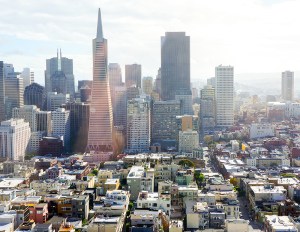Tech Workers’ Exodus Pressures San Francisco’s Economy
The city’s five-year financial plan details the impact of remote work on local economic conditions.

San Francisco. Photo by Lili Popper via Unsplash
Major metros with a booming economy, large talent pool and attractive cultural life used to dictate the pace of new trends and lifestyle choices across the U.S. The pandemic, however, has swept away the benefits of gateway cities and prompted residents to move to secondary markets, giving way to a more dispersed economy and employment base, or the “outpost economy” according to a report by Graceada Partners.
While smaller cities can capitalize on the benefits of remote working and relocation trends, primary markets are forced to take a deep dive before they are able to reinvent themselves. As major tech companies continued to announce plans to embrace the remote work culture beyond the pandemic, staying in an expensive city did no longer make sense. San Francisco’s tech crowd also packed up and left for other Californian cities such as Sacramento or Lake Tahoe, Graceada Partners reported.
READ ALSO: Why Suburbs, Secondary CRE Markets Will Benefit From the Next Recovery
According to Cushman & Wakefield, San Francisco’s office vacancy rate reached 16.7 percent at the end of the fourth quarter, up 300 basis points over the previous quarter and 11 percent compared to the same period of 2019. “San Francisco’s office market has suffered the nation’s most severe drop in occupancy and asking rents. Remote work and the pandemic have proven to be a major threat to the city,” said Joe Muratore, co-CEO of Graceada Partners.
Close-up on San Francisco’s economy

Photo by Dane Deaner via Unsplash
The flight of tech professionals had a significant impact on San Francisco’s overall economy. “As an office employment center, perhaps the most important single change to the city’s economy has been the immediate switch of office workers to remotely working from home,” according to a report detailing San Francisco’s five-year financial plan, released by the offices of the Mayor, the Controller, and the Board of Supervisors’ Budget and Legislative Analyst.
The report about the city’s financial plan also notes that office activities generated about 75 percent of the city’s GDP before the coronavirus outbreak. The absence of office workers has severely damaged the city’s downtown, and sales tax dropped by 43 percent between the second quarter of 2019 and the second quarter of 2020. Due to the exodus of tech workers, however, “the city also saw virtually no growth in online sales tax,” the report says. Muratore also expects a 10 to 15 percent drop in the value of downtown real estate and projects that the recovery might take four to six years.
Another indicator that the outmigration of office workers, specifically those in the tech industry, is putting downward pressure on San Francisco’s economy is that apartment rents have significantly dropped in areas where large concentrations of tech workers live, according to The Five-Year Financial Plan report. Asking rents decreased 25 percent in November 2020 compared to November 2019, the largest drop recorded in a major city across the country.
The Five-Year Financial Plan projects that San Francisco’s tax revenues will gradually recover in the next five years. However, the projections also show that the city’s expenditures will considerably outpace growth in tax revenues. The budget gap is expected to be $411 million in the 2021-2022 fiscal year and this deficit is expected to rise over the next five years. Although revenues are expected to return to pre-pandemic levels over the next five years, the gap between expenditures and revenues will be around $503 million if the city doesn’t take corrective action.
READ ALSO: Office Changes Are Here to Stay, NAIOP Panel Predicts
San Francisco’s recovery will heavily depend on office workers and their employers deciding whether they should return to their offices in the city or embrace the benefits of remote working, giving rise to the outpost economy away from primary office markets. “Organizations that understand the need to collaborate in physical space will lease new, smaller spaces in secondary markets and invite employees in the region to work in those spaces,” Graceada Partners’ report stated.
San Francisco will surely go through a rough recovery process. However, the city’s well-established culture and amenities that it has to offer will continue to attract people in the long-term, Muratore noted. Nonetheless, the city will have to find new ways to attract new businesses to secure its office market again.
“San Francisco is going through a 20 percent reinvention. Most of what we know worked will continue to work, but there will be people who need to come in and replace the Oracles, and the Pinterests of the city (…) That will be a four-to-six-year process and it will be challenging in some ways,” Muratore concluded.







You must be logged in to post a comment.